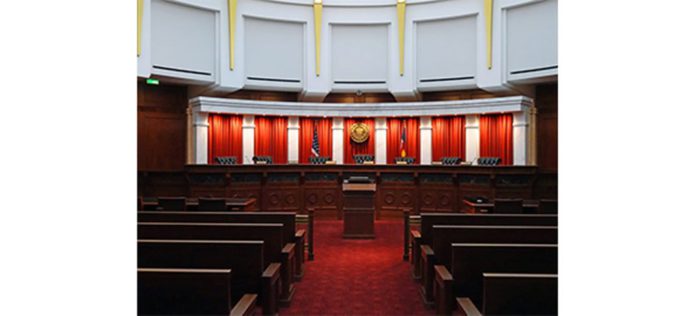
As Colorado’s court of last resort, its opinions become the final say on questions of law — but how do the opinions come into being? During the Colorado Judicial Institute’s Straight Talk with Justices on Sept. 17, justices Monica Márquez and Carlos Samour discussed the court’s process.
Oral arguments are typically held twice a month, whenever the court is in session. When scheduling oral arguments, a staff attorney reviews the cases at issue and sends a memo with proposals of arguments to Samour and Justice Melissa Hart, who are in charge of scheduling. The memo recommends the schedule and length of time for arguments with suggestions such as scheduling two cases with related issues as back-to-back arguments.
When preparing for scheduling, the court uses pre-argument memos prepared by the law clerk who prepared the initial petition for certiorari. The preargument memo summarizes what the case is about, and the law clerk collects any relevant cases, statutes and portions from the record.
Next, the justices review the memos in preparation for the oral argument and do their own independent preparation. Each justice reads briefs and performs their own research. They may look at the record when appropriate, and in some instances, law clerks may help research, aid and brainstorm.
Occasionally, the justices will pass on cases when they come across something complicated or someone comes up with a question, or the court seems to be in disagreement, for a couple of days or week, he said.
Once a case is heard and the justices are ready to make their ruling, the chief justice assigns majority opinions.
“I think the thing to keep in mind is that when you’re assigned an opinion, you’re not writing for yourself — you’re not writing what you think — you’re writing for the court,” Márquez said, and sometimes that can be a challenge to get four justices to consent on what the opinion ought to say.
At that point, the Chief Justice assigns that batch of cases to an individual justice “who happens to be in the majority,” Márquez said.
Unlike the U.S. Supreme Court, the chief justice doesn’t assign dissents, she said. Those in dissent join together and discuss who will lead the dissent. Typically, if a more senior justice in a dissenting group wishes to take the lead, they have the prerogative.
Drafts of majority opinions are circulated and reviewed, and justices put in preliminary votes indicating whether they concur or dissent, or whether they will write a separate opinion or are not yet ready to join an opinion. Márquez said she has experienced times when initial votes changed — where a concurring or dissenting opinion actually changed the thinking of the justices — “and in some cases the majority can actually flip.”
In such cases, a protocol of the court allows the authoring justice of the original opinion to either continue to write for the court, “so in other words they can actually change their opinion, change their vote and rewrite the opinion,” Márquez said. Or, alternatively, the authoring justice can stake their position and turn what had been a majority opinion into a dissenting opinion.
For weekly conferences, justices receive an agenda indicating which cases are up for discussion, which opinions are set for final vote and any petitions for rehearing, among other items.
The conferences usually last between two to three hours, and follow “a rule of juniority,” where the most junior justice speaks first before the vote, and the process works up the ranks until the last person to speak is the chief, Samour said.
The idea is that the most junior justice should not vote and speak after their more experienced counterparts have already spoken and voted and possibly be swayed by those other justices.
“There are protocols in place because this is a seven-member court, and if you don’t have protocols, and agreements in place, it just doesn’t work,” he said.
Further, before COVID-19, the justices had a rule that after conference they all went to lunch together. Samour feels this rule helps to breed congeniality after debating important issues that can cause some different opinions.
—Avery Martinez

